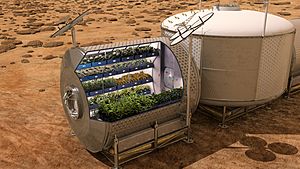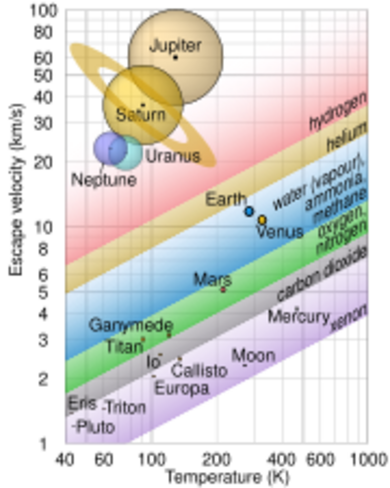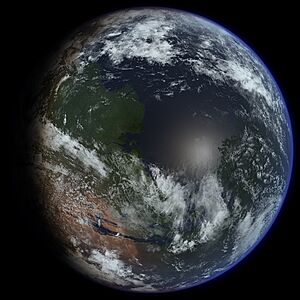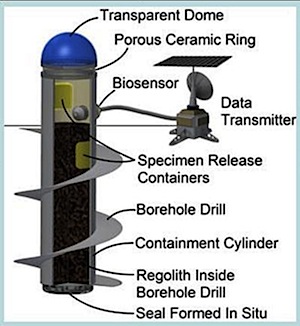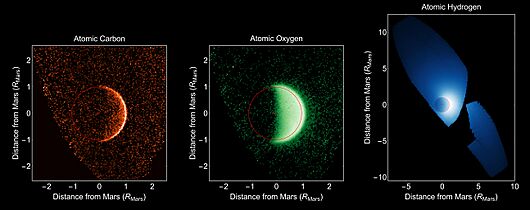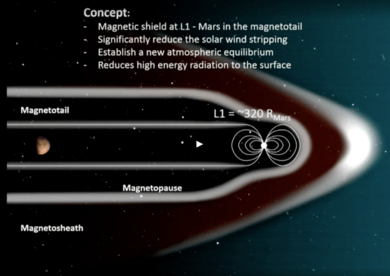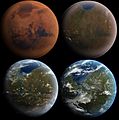Terraforming of Mars facts for kids
Terraforming Mars is a big idea to change the planet Mars so that people and other living things from Earth could live there without special suits or special buildings. It would mean changing Mars's weather, air, and ground. It would also involve creating new living systems on the planet.
Scientists think Mars once had a thick atmosphere and water, like Earth. This makes it a good planet to try and change. However, there are many challenges. Mars has low gravity, toxic soil, and not much sunlight. It also doesn't have a magnetic field to protect it.
Some people wonder if we have the technology to do this. Others worry about the cost or if it's right to change another planet. But many believe it could help Earth by giving us more resources and a backup home for humanity.
Contents
Why Terraform Mars?
As Earth's population grows and we need more resources, humans might need to live on other planets or moons. Mars is one of the best places to consider. Living in space would help us use the Sun's energy and materials from other planets.
Mars is the most Earth-like planet in our Solar System. Scientists believe Mars had an environment much like Earth's a long time ago. It had a thicker atmosphere and lots of water. But over millions of years, Mars lost most of its air. Because Mars is similar to Earth and relatively close, it's a top choice for terraforming.
One possible side effect of terraforming Mars is that it could harm any life that might already exist there.
What Are the Challenges of Terraforming Mars?
The environment on Mars makes terraforming very difficult. Scientists need to overcome many problems. Here are some of the main differences between Mars and Earth:
- Less sunlight: Mars gets only about 60% of the sunlight Earth gets.
- Low gravity: Mars's gravity is only 38% of Earth's. We don't know how this low gravity would affect human health over time.
- Unbreathable air: The air on Mars is mostly carbon dioxide and too thin to breathe.
- Very low air pressure: The air pressure is about 1% of Earth's. This is so low that liquids in your body would boil without a special suit.
- Radiation: There's a lot of harmful radiation from the Sun and space on the surface.
- Very cold: The average temperature is about -63°C (-81°F). Earth's average is about 14°C (57°F).
- No natural food: There are no plants or animals to eat on Mars.
- Toxic soil: The soil on Mars contains harmful chemicals.
- No global magnetic field: Mars doesn't have a strong magnetic field to protect it from the solar wind.
Protecting Mars from Solar Wind
Mars does not have a strong global magnetic field like Earth. This means the solar wind, which is a stream of charged particles from the Sun, hits Mars's atmosphere directly. Over time, this solar wind has stripped away much of Mars's air. Earth's ozone layer also helps protect us from harmful ultraviolet light.
If Mars had a magnetic field, it could help keep a new atmosphere from escaping into space.
Low Gravity and Pressure
The air on Mars is mostly carbon dioxide (CO2). It has about 1% of the pressure of Earth's air at sea level. Scientists think there's enough frozen CO2 in Mars's soil and south pole to create a thicker atmosphere if it warms up.
However, because Mars has lower gravity, it would need 2.6 times more air than Earth to reach a comfortable pressure. To get more air, we might need to bring in materials like ammonia from asteroids.
Breathing on Mars
The air pressure on Mars is so low that human body liquids would boil away. You would need a full pressure suit to survive for more than a few minutes. If the air pressure could be raised, people might only need to wear a mask that gives them pure oxygen.
In 2021, NASA's Perseverance rover successfully made a small amount of oxygen on Mars. But this process is slow and complex.
What Are the Advantages of Mars for Terraforming?
Scientists say Mars is on the outer edge of the "habitable zone." This is the area around the Sun where liquid water could exist on a planet's surface. If we could add enough greenhouse gases to Mars's atmosphere, it might get warm enough for liquid water.
There's strong evidence that Mars once had a thick atmosphere and lots of liquid water on its surface. Even now, there's a lot of water ice under the surface and at the poles. If all the ice at the south pole melted, it would create an ocean 5 to 11 meters deep across the whole planet.
The soil and air on Mars also contain many important elements for life, like sulfur, nitrogen, hydrogen, oxygen, phosphorus, and carbon.
When Mars warms up in its summer, frozen carbon dioxide at the poles turns into gas and enters the atmosphere. This creates strong winds that carry dust and water ice, forming clouds similar to Earth's.
Most of the oxygen on Mars is locked up in carbon dioxide (CO2) or in rocks. Scientists have found perchlorate in the soil, which can release oxygen. We could also use electricity to split water into oxygen and hydrogen if there's enough liquid water and power. However, any oxygen released into the atmosphere would eventually escape into space.
How Could We Terraform Mars?
| Air property |
Mars | Earth |
|---|---|---|
| Pressure | 0.61 kPa | 101.3 kPa |
| Carbon dioxide (CO2) | 96.0% | 0.04% |
| Argon (Ar) | 2.1% | 0.93% |
| Nitrogen (N2) | 1.9% | 78.08% |
| Oxygen (O2) | 0.145% | 20.94% |
To terraform Mars, three main things need to happen: building up a magnetic field, making the atmosphere thicker, and raising the temperature. Mars's atmosphere is very thin. But because it's mostly carbon dioxide, a greenhouse gas, it could help trap heat once Mars starts warming up. As it gets warmer, more CO2 would turn into gas from the frozen poles, making the greenhouse effect even stronger. This means the heating and thickening of the atmosphere would help each other. However, keeping the atmosphere from escaping is still a big challenge because Mars lacks a strong magnetic field.
Bringing in New Gases
One idea is to bring ammonia (NH3) to Mars. Ammonia is found in frozen form on small planets in the outer Solar System. We could try to crash these objects into Mars. Ammonia is a strong greenhouse gas, but it breaks down quickly in Mars's atmosphere into nitrogen and hydrogen. The nitrogen would stay longer, but the lighter hydrogen would escape fast.
Another idea is to bring methane (CH4) or other hydrocarbons. Methane is common on Titan, one of Saturn's moons. Methane is also a greenhouse gas, but it's even lighter than ammonia and would escape faster. It also breaks down in the Martian atmosphere within a few years.
Scientists have also suggested using very powerful greenhouse gases like sulfur hexafluoride or perfluorocarbons (PFCs). These gases are thousands of times stronger at trapping heat than CO2. They could be made on Mars using local materials, nuclear power, and a lot of industrial effort. Another way is to send rockets filled with these gases to crash into Mars.
Using Orbital Mirrors
We could place huge mirrors made of thin plastic film in orbit around Mars. These mirrors would reflect sunlight onto the surface, directly increasing Mars's temperature. A very large mirror, about 125 km (78 miles) wide, could be placed near the poles to melt the frozen CO2 ice sheets. However, launching such large mirrors from Earth would be very difficult.
Making Mars Darker
Making the surface of Mars darker would help it absorb more sunlight and heat up. This could be done by spreading dark dust from Mars's moons, Phobos and Deimos, which are very dark. Or, we could introduce dark microbes like lichens or algae. These tiny living things would make the ground darker.
If green life like algae were established, it would also produce a small amount of oxygen. However, this oxygen would escape into space unless a magnetic field was created. Also, Mars's frequent dust storms cover the entire planet, blocking sunlight and covering up any dark materials, which would undo the darkening efforts.
Growing Oxygen on Mars
Since 2014, NASA and Techshot Inc. have been working on an idea called the Mars Ecopoiesis Test Bed. They want to send small containers of oxygen-producing bacteria and algae to Mars. A rover would screw these containers into the Martian soil where liquid water might appear. The organisms would grow inside the sealed soil and produce oxygen. This experiment would help scientists see if it's possible to grow oxygen on Mars.
If this works, they could build larger sealed structures called "biodomes" to produce oxygen for future human missions. Making oxygen on Mars would save a lot of money because astronauts wouldn't have to bring heavy oxygen tanks from Earth. This process, called ecopoiesis, is not meant to terraform the whole planet's atmosphere, but it's a big step for planetary biology.
Research in 2015 also suggested that some types of microbes called methanogens could survive in Mars's low pressure. These microbes don't need oxygen or organic food. They use hydrogen for energy and carbon dioxide for carbon, so they could live underground on Mars.
Protecting the Atmosphere
A key part of terraforming Mars is protecting its atmosphere from being lost into space. Some scientists think we could create an artificial magnetic field around the planet. Japanese scientists have suggested building a system of refrigerated superconducting rings around Mars. These rings would carry a strong electric current to create a magnetic field. This system could also store and transfer energy for the planet.
Magnetic Shield at L1 Orbit
In 2017, NASA scientist Jim Green proposed placing a large magnetic shield between Mars and the Sun. This shield would be located at a special point in space called the Lagrange orbit L1. It would create a partial magnetic field to protect Mars from harmful solar particles. If built, this shield might allow Mars to slowly get its atmosphere back.
Images for kids
See also
 In Spanish: Terraformación de Marte para niños
In Spanish: Terraformación de Marte para niños
- Astrobotany
- Colonization of Mars
- Human mission to Mars
- Mars habitat
- Mars in fiction#Terraforming
- Terraforming of Venus


